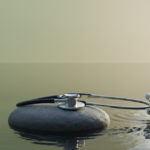As physicians, we’re used to thinking about dose (how much medication, how often, and for how long). But there’s another dimension that’s often overlooked: time. For decades, we’ve known that the body processes medicines differently depending on the time of day. A blood pressure pill or chemotherapy drug can have markedly different effects depending on when it’s taken. This field, known as chronopharmacology, has transformed how we think about drug delivery. Yet the same principle rarely enters conversations about everyday environmental exposures (what patients encounter through food, beauty products, or the air they breathe).
What if timing also determines how our bodies absorb, metabolize, and respond to chemicals in these everyday settings? That question forms the basis of what I call chrono-exposomics: the study of how timing interacts with the body’s internal circadian clock to shape risk.
The body keeps time
Nearly every organ in the body operates on a 24-hour rhythm. The skin, our largest organ, is more permeable in the evening. The liver, our detox powerhouse, clears chemicals more efficiently during the day. Hormones rise and fall on tightly choreographed cycles that influence everything from metabolism, mood, and reproduction. In short, the body keeps time; and so do its risks. This means that an exposure at 8 a.m. may not be biologically equivalent to the same exposure at 8 p.m.
A case study: nail products
Consider the simple act of getting a manicure. Millions of people worldwide use nail products regularly, often without much thought. Yet many of these products contain chemicals known to disrupt hormone signaling, including endocrine-disrupting compounds like phthalates and organophosphate esters. A recent European Union regulation banned TPO (trimethylbenzoyl diphenylphosphine oxide), a photoinitiator used in gel manicures to harden polish under UV lamps. The reason? It was classified as a reproductive toxicant. But beyond TPO, researchers have detected other manicure-related chemicals, such as triphenyl phosphate (TPHP), in users’ urine just hours after application. In other words, these compounds are absorbed quickly and systemically.
Timing and absorption
If our skin and liver follow daily rhythms, then it stands to reason that the time of exposure could influence how much is absorbed and how long it lingers. In the evening, skin permeability and peripheral blood flow rise, while hepatic detoxification slows. In the morning, detox enzymes are at their peak, and the skin barrier is more robust. That combination could mean an evening manicure results in a higher internal chemical dose than one done earlier in the day. While this hasn’t yet been directly studied, it’s a hypothesis worth testing, especially given what we know about fertility and circadian rhythms.
Why fertility is especially vulnerable
Reproduction is one of the body’s most rhythm-sensitive systems. Hormone surges, ovulation, implantation, all depend on precise circadian timing. Disrupt those rhythms, and the effects can be significant: irregular cycles, lower egg quality, and impaired hormone signaling. For patients already struggling with infertility, environmental exposures that interact with circadian misalignment could compound existing challenges. Research on salon workers supports this concern. Studies have shown higher levels of phthalate and phosphate metabolites among nail technicians, levels linked to lower ovarian reserve and altered reproductive hormone profiles. Yet the potential role of timing in these exposures has never been explored.
Practical implications
Until we have more data, small, evidence-informed adjustments can help patients reduce potential risk without abandoning self-care routines:
- Choose safer formulations: Opt for TPO-free or “3-free”/”5-free” polishes, ideally those meeting EU ingredient standards.
- Book morning appointments: Earlier sessions may mean lower absorption and faster clearance.
- Protect the skin: Avoid contact with the cuticles, use gloves for at-home applications, and apply mineral sunscreen or UV-protective gloves during curing steps.
- Ventilate well: Open windows or use fans to reduce inhalation exposure. For frequent users, consider “manicure breaks” to allow for detox recovery.
Looking ahead
The next frontier is scientific: measuring how circadian timing alters chemical absorption and metabolism. Imagine a study comparing morning versus evening manicures while tracking chemical metabolites, hormone levels, and sleep patterns. Such research could illuminate how timing shapes exposure risk, and perhaps even guide new safety standards for consumer products. Chrono-exposomics, as a concept, bridges what we already know about circadian biology and toxicology. It reminds us that prevention isn’t just about avoiding exposure, but about aligning with the body’s natural rhythms.
The takeaway
The beauty of this idea is its simplicity: Our biology has a schedule, and so should our choices. For patients navigating fertility, small timing adjustments (whether in sleep, diet, or daily routines) may offer another layer of protection and empowerment.
The body keeps time. Perhaps our exposures should, too.
Oluyemisi (Yemi) Famuyiwa is a renowned fertility specialist and founder, Montgomery Fertility Center, committed to guiding individuals and couples on their path to parenthood with personalized care. With a background in obstetrics and gynecology from Georgetown University Hospital and reproductive endocrinology and infertility from the National Institutes of Health, she offers cutting-edge treatments like IVF and genetic testing. She can be reached on Linktr.ee, LinkedIn, YouTube, Facebook, Instagram @montgomeryfertility, and X @MontgomeryF_C.



















![Why mocking food allergies in movies is a life-threatening problem [PODCAST]](https://kevinmd.com/wp-content/uploads/Design-3-190x100.jpg)
![Why being your own financial planner is costing you millions [PODCAST]](https://kevinmd.com/wp-content/uploads/Design-1-190x100.jpg)
